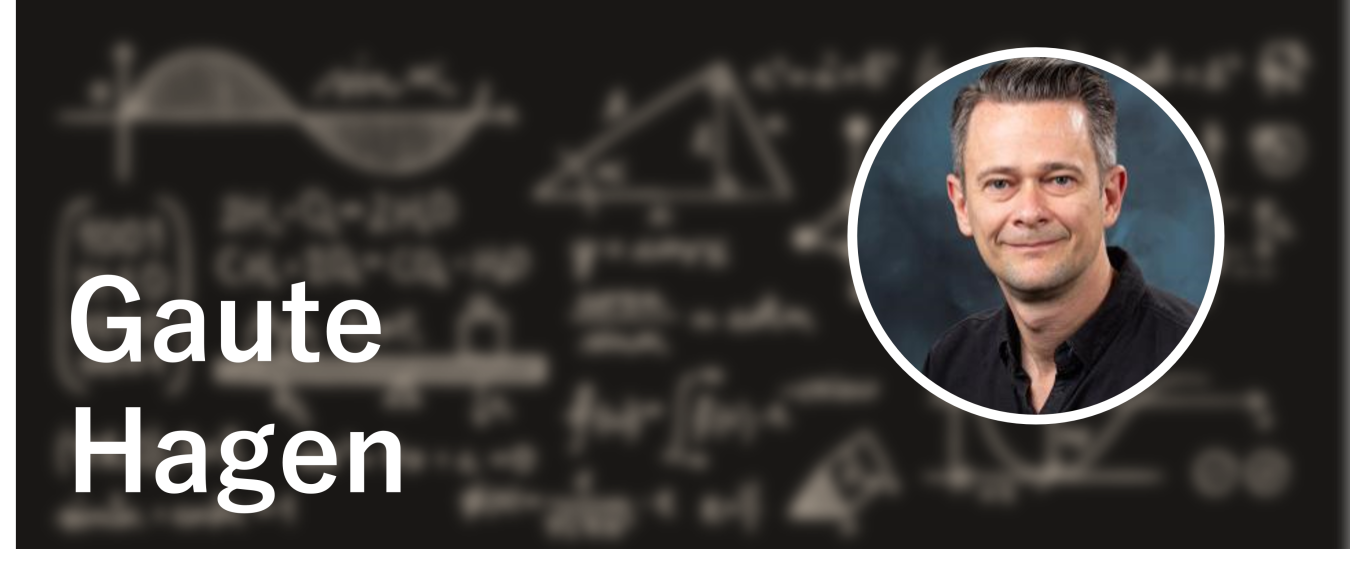Gaute Hagen used his 2013 Early Career Research Program award to investigate state-of-the-art computations of weak processes in nuclei.
July 7, 2025WHAT DID THE 2013 EARLY CAREER AWARD ALLOW YOU TO DO?
The frontier of nuclear physics aims to understand the nature of atomic nuclei and how they may be used to answer fundamental questions such as: Why is there more matter than antimatter in the universe? What is the nature of the neutrino? How do properties of nuclei impact the physics of neutron stars and astrophysical processes?
These questions lie at the heart of my 2013 Department of Energy (DOE) Early Career Award to investigate state-of-the-art computations of weak processes in nuclei. Fully explaining the inner workings and multi-scale complexity of nuclei is an enormous undertaking.
I aimed to provide a highly-detailed and unified description of nuclei that is predictive and related to the underlying theory of the strong interaction. The strong force is a fundamental force that holds subatomic particles together to form larger particles. The theory that describes these interactions is called quantum chromodynamics. This “first principles” approach was made possible using state-of-the-art quantum many-body methods, knowledge of nuclear interactions with roots in quantum chromodynamics, and supercomputing. Quantum many-body methods allow us to study systems that have many quantum particles interacting together.
To begin, I asked a basic question: How big are atomic nuclei?
With colleagues, I calculated the neutron distribution in the neutron-rich nucleus calcium-48. Surprisingly, it is smaller than scientists previously thought. This finding impacts the equation-of-state that describes the structure of nuclear matter and neutron stars. The recent Calcium Radius Experiment (CREX) at the DOE’s Jefferson Lab confirmed our prediction. They used a special way of scattering electrons to extract the neutron distribution.
The DOE Early Career Award also allowed me to work with scientists from around the world to solve a puzzle that’s been around for 50 years. We wanted to know why beta decays of atomic nuclei (a process where protons convert into neutrons, or vice versa) are slower than expected based on the beta decays of free neutrons.
We performed a comprehensive study of beta decays that ranged from lightweight nuclei to the heavy nucleus tin-100. We found that the inclusion of correlated interactions between two nucleons and a proper treatment of strong nuclear correlations resolves this long-standing puzzle.
These accomplishments, enabled by the Early Career Award, demonstrate the predictive capabilities of our approach. A wealth of new data is coming from next-generation accelerators and detectors to compare with our predictions. We have a great chance to learn more about the inner workings of atomic nuclei and how they may be used as laboratories to search for new physics.
ABOUT:
Gaute Hagen is a Distinguished Staff Research Scientist at DOE's Oak Ridge National Laboratory.
SUPPORTING THE DOE SC MISSION:
The Early Career Research Program provides financial support that is foundational to early career investigators, enabling them to define and direct independent research in areas important to DOE missions. The development of outstanding scientists and research leaders is of paramount importance to the DOE Office of Science. By investing in the next generation of researchers, the Office of Science champions lifelong careers in discovery science.
For more information, please go to the Early Career Research Program page.
THE 2013 PROJECT ABSTRACT:
Title
State‐of‐the‐Art Microscopic Computations of Weak Processes in Nuclei
Abstract
Electroweak processes such as beta decay in atomic nuclei address fundamental questions such as: “What are the mechanisms for the production of elements heavier than iron? What is the nature of the neutrino? What is the electroweak charge distribution in nuclei?” Beta decay rates are crucial input for nucleosynthesis simulations that aim at determining the origin of elements, and also for understanding the nature of the neutrino (“Is the neutrino its own anti‐particle?”).
The aim of the planned research is to address these questions by state‐of‐the‐art microscopic computations of weak nuclear decays with quantified uncertainties. By developing novel extensions of the coupled‐cluster method, this research will make predictions of properties of medium‐mass, neutron‐rich nuclei at a microscopic level.
The planned research will be relevant for the future experiments aimed at measuring the weak charge distribution in calcium‐48 at Jefferson Lab, neutrinoless double‐beta decay experiments with the Majorana Demonstrator, and beta decay lifetimes for astrophysically relevant exotic nuclei such as Nickel‐78 and Tin‐132 studied at the Facility for Rare Isotope Beams (FRIB). These advanced calculations, based on two‐ and three‐nucleon interactions, will shed new light on the microscopic mechanisms behind weak decays such as neutrinoless double‐beta decay, and will help constrain nuclear forces.
RESOURCES:
A Ekström, GR Jansen, KA Wendt, G Hagen, T Papenbrock, BD Carlsson, C Forssén, M Hjorth-Jensen, P Navrátil, W Nazarewicz, “Accurate nuclear radii and binding energies from a chiral interaction.” Phys. Rev. C91, 051301(R) (2015). [DOI: 10.1103/PhysRevC.91.051301]
G. Hagen et al., “Neutron and weak-charge distributions of the 48Ca nucleus,” Nature Physics 12, 186 (2016). [DOI: https://doi.org/10.1038/nphys3529]
P. Gysbers, G. Hagen, et al., “Discrepancy between experimental and theoretical β-decay rates resolved from first principles,” Nature Physics, volume 15, 428 (2019). [DOI: 10.1038/s41567-019-0450-7]
Additional profiles of the Early Career Research Program award recipients can be found at the Early Career Program highlights page.
The Office of Science is the single largest supporter of basic research in the physical sciences in the United States and is working to address some of the most pressing challenges of our time. For more information, please visit the Office of Science website.


